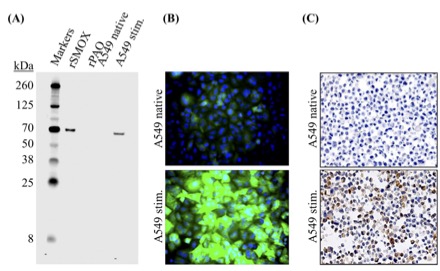Spermine oxidase (SMOX) is an enzyme that converts the polyamine spermine to spermidine, producing reactive hydrogen peroxide and aldehydes as byproducts that can damage DNA and other biomolecules. SMOX activity is linked to DNA damage, inflammation, and carcinogenesis. Antibodies suitable for immunofluorescence and immunohistochemistry are essential to visualize human SMOX (hSMOX) in various tissues or cell lines, yet there is a lack of adequately characterized antibodies for identifying SMOX.
To support ongoing efforts of Dr. Antonietta Impagliazzo’s research groups from Janssen Vaccine and Prevention (Leiden, The Netherlands), Janssen Research & Development, Spring House (PA, USA), and Precision for Medicine (UK labs), Royston (United Kingdom), we produced a panel of high-affinity rabbit monoclonal antibodies against various hSMOX epitopes using Exonbio’s Single Plasma Cell Interrogation (SPIN®) technology.1
For this study, we immunized female rabbits with different purified peptide sequences of hSMOX, after which the rabbits were euthanized, and spleens were harvested for monoclonal antibody development.
How our SPIN® technology stands out: rapid processing
Mature plasma cells, which exclusively harbor mature antibodies, have significantly higher antibody mRNA levels than their precursor B cells. Isolation of these fully developed plasma cells substantially enhances the probability of generating antibodies with enhanced affinity and specificity.
Because these cells constitute merely 0.1% of the total B cell population, we could achieve substantially shorter screening times by focusing on the isolation of only mature plasma cells with our patented SPIN® technology compared to traditional methods that focus on all B cells.
How our SPIN® technology stands out: highly efficient screening
Rabbit splenocytes are subjected to a two-step screening, which starts with a large-scale efficient fluorescence activated cell sorting (FACS) to isolate antigen-specific plasma cells from millions of splenocytes followed by secondary testing of individual plasma cells for their recombinantly expressed antibodies in the supernatant. Screening this way allows us to find rare antibodies with 500-fold greater efficiency than traditional methods.
Developed monoclonal antibodies are suitable for most common applications
Commercially available antibodies against hSMOX are polyclonal antibodies with limited validation. Therefore, there is a need for highly specific monoclonal antibodies that recognize this enzyme, which is now being viewed as a potential drug target in various cancers and inflammatory diseases.
When the researchers evaluated three commercially available affinity-purified polyclonal antibody preparations in western blot and immunofluorescence analyses, they noted high non-specific binding.
“We surmised that the commercial polyclonal antibodies lacked the specificity and sensitivity required for our purposes.”
Therefore, a series of high-affinity monoclonal antibodies were developed from rabbits immunized with peptide long loop 1 (LL1) and native recombinant hSMOX. ELISA screens were used to characterize the candidate antibodies.
The developed monoclonal antibodies were found to be especially suitable for western blot, immunofluorescence, and immunohistochemical analyses due to the low background signal and excellent contrast in cell lysates (Figure 1).

Figure 1. The developed monoclonal antibodies are suitable for most analytical applications. (A) Western blot analysis: Signal intensities were 8–13-fold higher in stimulated versus non-stimulated A549 cells, with negligible background staining (representative SMAB3 clone shown). (B) Immunofluorescence analysis: Strong fluorescence intensities was seen in the stimulated A549 cells and not in the non-stimulated cells (representative SMAB3 clone shown). (C) Immunohistochemical analysis: A clear contrast was seen between the staining in stimulated versus non-stimulated A549 cells (representative SMAB10 clone shown).
“The antibodies characterized here should meet the needs of most investigations involving hSMOX detection on gels, in solution, and in mammalian cells and tissues.”
Conclusion
The monoclonal antibodies developed using our SPIN® technology can be reproducibly generated in large quantities from recombinant expression and are suitable for most common applications, addressing the limitations of lot-to-lot variability and the restricted choice of environmental conditions associated with polyclonal antibodies.
References
1. Tepper AWJW, Chu G, Klaren VNA, Kalin JH, Molina-Ortiz P, Impagliazzo A. Development and characterization of rabbit monoclonal antibodies that recognize human spermine oxidase and application to immunohistochemistry of human cancer tissues. PLoS One. 2022;17(4):e0267046. Published 2022 Apr 22. doi:10.1371/journal.pone.0267046